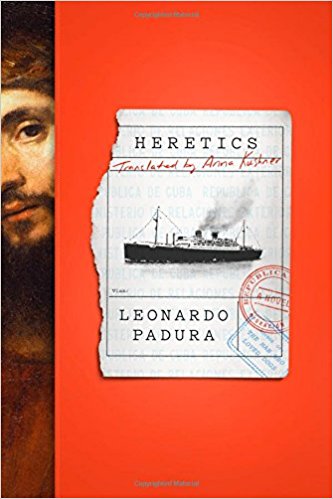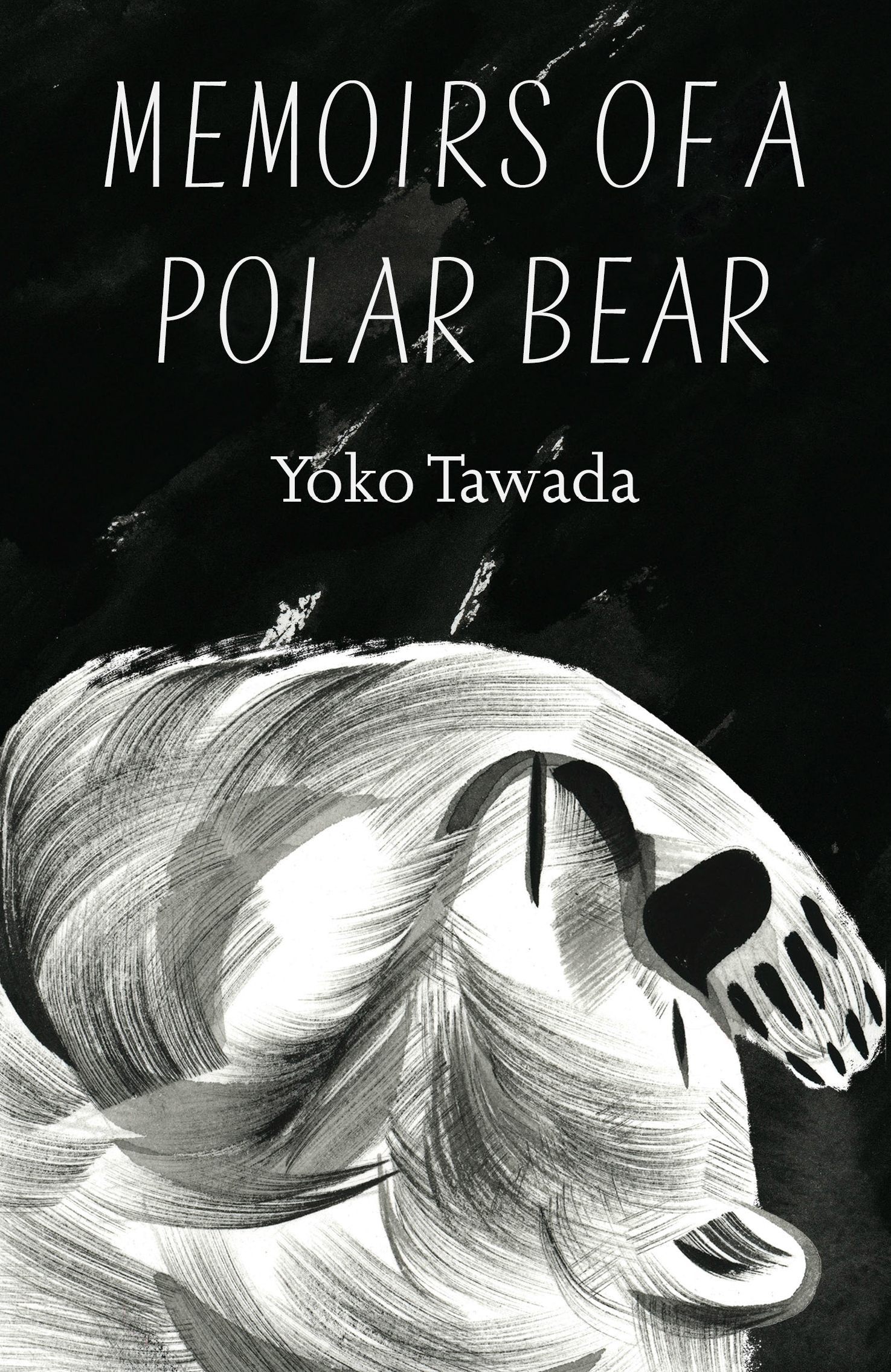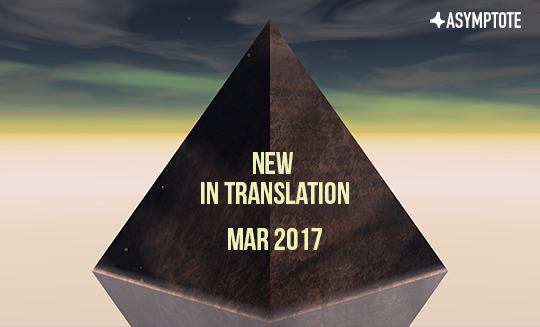
Heretics by Leonardo Padura, tr. by Anna Kushner, FSG
Review: Layla Benitez-James, Podcast Editor
Leonardo Padura’s novel, Heretics, has finally made its way to North American shores and English speakers everywhere thanks to translator Anna Kushner’s work for Farrar, Straus and Giroux. Originally published by Tusquets Editores of Spain as Herejes in 2013, Heretics is a startlingly, and in many ways disturbingly, relevant work for 2017—as rising levels of xenophobia and nationalism are straining already tense relationships across many borders and affecting refugees throughout Europe and North America. Padura’s novel opens in the Havana of 1939 with the rejection of the St. Louis, a German transatlantic liner sailing from Hamburg whose 937 almost entirely Jewish passengers were fleeing the Third Reich. Their tragic return to Europe—a effective death sentence—is watched by Daniel Kaminsky, the first character introduced and the namesake of the first of the novel’s four sections. Daniel has high hopes in his nine-year-old heart that his parents and sister aboard the ship will make it to land.
At 525 pages, Padura has ample space to leap through an ever thickening plot as his characters become more and more entangled in a seemingly unlikely series of events. Yet the read is a quick one, driven forward by drastic jumps between Havana and Amsterdam and a narrative structure which throws the reader several curveballs in the pages where a more traditional detective story might feel the need for resolution. It’s especially relentless in its final two dozen pages. This book, addicting in and of itself, will also compel readers to dive into the real history of the events on which it centers; they are oftentimes much stranger than any fiction could hope to be, even though Padura tells us right before we embark that “history, reality, and novels run on different engines.” However, to describe the work as a historic thriller, or even to focus on the mystery of a stolen Rembrandt that is woven throughout the larger plot, only hits at one level of Padura’s game. He lets us fall through history almost effortlessly, revealing the inevitable repetition of human cruelty from biblical times through the 17th century, the 20th and up through our own muddy 21st. He neither sugar coats nor exploits these horrors, to his credit.
While the novel takes one of Padura’s recurring characters, Mario Conde, as its hero, a reader uninitiated into this Cubano’s world will have no trouble becoming quickly acquainted. His prose style is elliptical; events and ideas are repeated by different characters as if Padura holds each piece of plot up to the light like a precious stone, turning it this way and that to appreciate its different angles and facets. Though Salinger undoubtedly receives the most attention, influences from Chandler, Hemmingway, Murakami, Kundera, and the occasional phrases from Voltaire’s Candide, which perhaps even inspired the name of Conde’s most pious friend, Candito, also find their place. Readers will note quite a bit of Nietzsche, too, as our hero is forced to try and make sense of the emo subculture springing up on the Island, not to mention a healthy dose of Blade Runner and Nirvana references to even things out.
Perhaps one of the most delightful plays between reality and fiction is the one Padura plays with the genre itself. Despite some dark passages, the work is deeply humorous and self-reflective, especially in the periodic wish of our narrator to compose his own hard-boiled thriller as he continually feels trapped in one himself. No stranger to taking on huge historical figures (from Adiós Hemmingway to The Man Who Loved Dogs, which stars Leon Trotsky), Padura’s Rembrant is compelling and once again does that work of blurring fact and fiction that inspires a desire for the work to have come wholly from the real world.

Memoirs of a Polar Bear by Yoko Tawada, tr. by Susan Bernofsky, Granta/New Directions
Review: Alice Inggs, Editor-at-Large for South Africa
Yoko Tawada is known for writing unstable universes. A buzzing fly might become a sentence bumping against the forehead; an earache a pregnancy. The effect is dissociation, like fumbling for meaning in a foreign language, or getting lost in an unfamiliar city.
There is always an internal logic to the worlds Tawada creates, though, producing a deft narrative balancing act between striking realism and the surreal. Tawada’s sentences are supple, her metaphors charged with distinctive but reasoned strangeness: willow trees are ‘elegant, cunning, and overcome with ennui…poking their thin fingers into the water, perhaps hoping it would play with them’; peeling wallpaper hangs down ‘like burned skin.’
In Memoirs of a Polar Bear, Tawada’s sixth novel, three generations of polar bears produce autobiographies. Life is performance and self-writing a kind of star act for the matriarch bear, her daughter Tosca, and Tosca’s son, Knut. ‘Many times in the past I had danced atop a gigantic ball, ridden a stunt tricycle and a circus motorcycle,’ writes the Matriarch. “But publishing an autobiography was a far more dangerous acrobatic feat.” The danger and tragedy here is not in the performance of self, but in the contortion required to make oneself understood.
There is a sense that the three bears are in a liminal state, writing themselves into being and awakening to how they are perceived by other creatures, both human and animal. In chapter one, the Matriarch produces a bestselling autobiography describing her life behind the iron curtain. Chapter two follows her daughter, Tosca, born in Canada but moved to take a circus job in the DDR. Chapter three is about Knut, Tosca’s son, who was raised in a Leipzig zoo.
The bears swing between the poles of becoming human and becoming animal, but as they approach one form or the other, they lose something of themselves that seems to exist only when their idea of the self is unfixed. “I’d always thought it was the floor feeling pain—not me—so it was the floor that had to change––not me––to make the pain go away. How I struggled until finally I learned to stand upright!” says the Matriarch. Each chapter contributes to the process of erasure through awareness.
For Tosca, the ability to speak to humans is lost. Tosca’s trainer, Barbara, narrates her biography, although Tosca is able to speak to Barbara in dreams. The distance between human and animal, self and other, gapes and closes; thoughts become words, words become signs. Tosca explains to Barbara how to make room in her soul for a bear, an attempt, perhaps, to reclaim her voice, or to show the possibility of dual selves. You start to wonder: who is telling whose story?
For Knut, the third bear and Tosca’s son, the subjective “I” has vanished. Knut initially speaks in third person. Where the Matriarch is a definite subject, essentially human but for being a bear, Knut is, at first, more object than subject. He is a captive in a zoo, mocked by another inmate for his peculiar way of speaking.
Casting the “I” in each autobiography as a bear (rather than a human) makes room for new metaphors, more potent for their context. This is particularly evident when a woman on a train calls the matriarch bear “an ethnic minority.” At this point in the story, the Matriarch is inadvertently escaping from behind the iron curtain to live in West Germany. “Was exile a kind of tightrope walking, a feat worthy of reward?” she asks. “Admittedly it was a challenge to pull off such a stunt without rehearsal or support, but I wasn’t finding it so terribly difficult.” As climate change eats away at the icecaps, the polar bear becomes a compelling symbol for displacement.
Indeed, displacement, exile, and otherness are chords that strike again and again in the three narratives. “Behind my back other children called me ‘snout face’ and ‘snow baby,’” remembers the Matriarch. “Until then, I’d never asked myself what I looked like in my classmates’ eyes. The shape of my nose, the color of my fur made me stand out from the majority—it took hearing those nicknames to bring this home to me.”
Memoirs of a Polar Bear comes across as an experiment in how to translate foreignness to a reader. The familiar, the everyday, is recast in new, alien forms. In this masterful performance of ‘otherness,’ Tawada pushes us to feel the humming possibility between how things appear and what they could be.

Burnt Land by Tua Harno, tr. by Kristian London, AmazonCrossing
Review: Hanna Heiskanen, Contributing Writer from Finland
Having read Tua Harno’s Burnt Land, I now have a new phobia that follows me to my dreams: deserts.
The Australian soil—red and dry, unyielding, it sticks to every surface and invades every orifice in its wake—might as well be the second protagonist of Harno’s novel. The first is Sanna, a Finnish graduate student in her early thirties, who has travelled to the town of Kalgoorlie in Western Australia to research the gender equality politics of the local mining company. In a town where men outnumber women ten to one, the threat to Sanna’s physical safety is palpable, from the local pool bar, where the miners spend their free time squeezing sweaty beer cans and staring at the thong-clad girl behind the bar, to the hotel room that shuts with a cardboard door and will never cool off.
And, just outside of town, the mine called Super Pit spreads out like a scar on the earth’s surface, unbearably vast, rust-colored, seemingly devoid of life, yet teeming with men commanding machines that tirelessly scrape off layers of rock. Rather improbably, this is where she meets another Finn, Martti, a decade older than her and employed by the mining company. They fall into something approaching love, but there’s a problem: Sanna is pregnant with her ex. Before she can let happiness into her life, she must face the past—and the desert.
In attempting to come to terms with her dysfunctional childhood family dynamics and unhappy previous relationship, Sanna meets Ralda, a professor of anthropology as well as a charismatic Aboriginal spiritual healer. Ralda convinces Sanna that to truly understand herself and move on, she must accompany her on a hike in the desert lasting several weeks: “Ralda was waiting for her, and the knowledge was as exhilarating as scorching your back in the highest, hottest spot in the sauna, then plunging into a frigid springtime lake in a puff.” Though they are both aware of Sanna’s pregnancy, the pair set off of on the highway, into the red, the past, the dreamtime, where all that is and has been is the desert, the wind, the sun, and the occasional cry of a bird. After Ralda loses Sanna’s mobile phone and destroys their map, her survival depends entirely on her guide.
If all this reminds you of a psychological thriller, you’d be a bit misled. There is certainly a mind-game element to the story, but Harno’s book is much more than that. It’s a study of people in situations where they feel without a choice, from Sanna’s hike to Martti’s grief, to a mother in a mining town clutching a child that isn’t hers, and a miner ready to end it all. It’s also a study of power: the power we willfully hand over to others, and the power that we have no choice over. Harno is particularly skillful with the desert sections, setting a scene where the earth, so tranquil and beautiful on the surface, simmers with fear, death, and melancholia.
If anything, Harno’s second novel seems to suggest that to be at peace, one must return to the past, or at the least carry it alongside the present. This is not a book to lift the spirits, but it is worth the experience of reading. Kristian London is an experienced American translator of Finnish literature, but I felt his version fell just a little short of Harno’s, who has been trained in dramaturgy.
*****
Read More Book Reviews:

